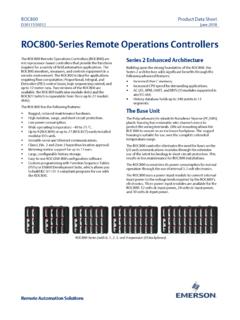Transcription of Multi-functional Timer relay. - 3rdbrakeflasher
1 Multi-functional Timer relay. User Manual 12/26/2017 !!! Warning !!! DO NOT return the item to the original retailer. Contact the support for any problem with the item or item delivery. Like us on Facebook YouTube Channel Page 2 Table of Contents 1. Multifunctional Timer Relay description .. 3 2. Timer wiring diagram .. 4 Connecting 5amp Timer .. 4 Connecting 10amp positive output Timer .. 4 Connecting 10amp negative (sink) output Timer .. 5 3. Understanding Timer Delay Relay 5 4. Timer function table with charts .. 6 5. Timer trigger.. 16 Timer trigger operation with charts.
2 16 Example of trigger setup.. 17 Timer trigger configuration 18 6. Timer Output mode .. 18 7. Timer Output type .. 19 8. Time programming modes.. 19 9. Timer installation and programming.. 20 10. Reseting Timer to the factory settings.. 22 11. Timer application examples .. 23 Extend current capacity be adding external 23 Extend current capacity be adding external 23 Use button to create self latching Timer .. 24 Use button to create self latching Timer with ability to turn off .. 25 Delay Off Timer with 0 power consumption in Off state .. 26 12. 10 amp Timer .. 27 13. 10 amp Timer with LCD .. 28 14.
3 Accessories .. 29 Timer configuration button board .. 29 15. YouTube Videos .. 30 16. Older Manuals .. 30 Like us on Facebook YouTube Channel Page 3 1. Multifunctional Timer Relay description Multifunctional Timer delay module is a revolutionary circuit with many commonly used Timer delay functions. It is perfect for many applications from hobby to industrial controls. The Timer has more than twenty different timing functions with optional ability to trigger them by application of input voltage to the trigger wire or opening/closing dry contacts. The Timer can be used for hundreds of various applications from delaying power to the circuit, supplying power in cycling fashion or creating self-latching timed circuit.
4 The Timer is easy to connect and configure. All the configurations are permanently saved into the internal flash memory. The Timer works with 5V to 20V supply voltage and can handle up to 5amp/10amp of current. This make makes it applicable to the variety of applications. Maximum current can be extended with the use of the external relay. Voltage range: 5v-20v Max current: 5amp or 10amp Minimum time duration: second Maximum time duration: 400 days Timer current consumption: Like us on Facebook YouTube Channel Page 4 2. Timer wiring diagram Connecting 5amp Timer Connecting 10amp positive output Timer ** For up to date installation instructions and videos visit View Timer s Cook Book at: Like us on Facebook YouTube Channel Page 5 Connecting 10amp negative (sink) output Timer 3.
5 Understanding Timer Delay Relay Function. Understanding all the time delay relay functions available in multifunctional Timer can be an intimidating task. During the circuit design with the Timer relay and variety of Timer configuration, questions such what initiates the Timer delay functions, does the timing starts with the application of the power or trigger signal, for how long output power should stay on, etc., could arise and must be answered. The Timer is simply a logic control circuit with the purpose of controlling the output power based on the events. Typically, Timer initiated or triggered by one of two methods: Application of power voltage High or low trigger signal The trigger signal can be one of the following: A control switch (dry contacts): limit switch, push button, float switch Voltage (power trigger): signal output from another device, power signal To help understand the Timer functionality let s look at common terminology used throughout this manual.
6 Input Voltage power voltage applied to the Timer . Depending on selected function, input voltage will either initiate the timing event or power the Timer to be ready to accept the trigger signal. Trigger Signal in certain timing functions, a trigger is used to initiate timing event after input voltage has been applied. As noted above this trigger can either be a control switch (dry contact switch) or a power trigger (voltage). Output output voltage from the Timer . Timing of the output voltage is controlled by the selected timing event and trigger method. Like us on Facebook YouTube Channel Page 6 Below (Figure 1) is a description of timing functions.
7 A timing chart shows the relationship between Input Voltage, Trigger Signal and Output. Note that Trigger Signal is optional for some of the Timer functions and mandatory for others. Before going through all the available functions look at the first one in details. Figure 1. # Function Operation Timing chart 1 ON DELAY Upon application of input voltage, the time relay (t) begins. At the end of the time delay (t), the output is energized. Input voltage must be removed to reset the time delay relay & de-energize the output. The Timer function #1 is ON DELAY, it allows to supply power after a period of time (t).
8 There are two timing charts, one without a trigger and one with the trigger. Trigger selection can be done during Timer configuration. Let s look at the first chart where the Timer is triggered by the supplied input voltage. Once power is supplied to the Timer , time delay (t) begins, at the end of the time delay (t) output is energized and stays on until power to the Timer is removed. Removal of the power resets the Timer circuit and the Timer is ready for another cycle. The second chart is applicable when trigger option is selected. In this particular case, trigger on High (positive) voltage is selected. More on trigger options can be found later in the manual.
9 Upon application of power, the Timer is ready to accept the trigger signal. When trigger is applied, time delay (t) begins. At the end of the time delay (t) output is energized and stays on until power to the Timer is removed. Another application of the trigger during time delay (t) or during the output energized period, has no effect on the Timer function. Only the first application of the trigger matters. 4. Timer function table with charts (Note that function number # will be used during Timer configuration.) Figure 2. # Function Operation Timing chart 1 ON DELAY Upon application of input voltage, the time delay (t) begins.
10 At the end of the time delay (t), the output is energized. Input voltage must be removed to reset the time delay relay and de-energize the output. Like us on Facebook YouTube Channel Page 7 # Function Operation Timing chart 2 INTERVAL ON Upon application of input voltage, the output is energized and the time delay (t) begins. At the end of the time delay (t), the output is de-energized. Input voltage must be removed to reset time delay relay. 3 FLASHER (On First) Upon application of voltage, the output is energized and the time delay (t) begins. At the end of the time delay (t), the output is de-energized and remains in that condition for the time delay (t).




